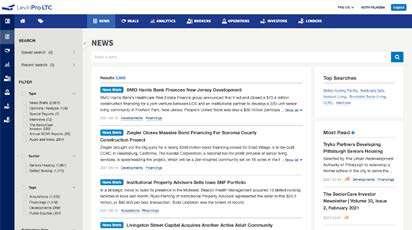Resignation and Realism
The Motto of Many at NIC Could Also Be “Survive Til ‘25”
The mood at the 2023 Fall NIC Conference in Chicago was pretty down, as most seemed resigned to the reality of interest rates staying higher, for longer. That could actually help M&A activity if investors stop delaying their deal strategies in hopes of rates falling soon.
See article at right
Skilled Nursing M&A
On October 19th, a panel of experts convened on a webinar to discuss the skilled nursing M&A market, how it reached its peak in 2021/22, how the lending environment has worsened and what will happen to values in 2024.
See article at right
Skilled Nursing Acquisitions...........Page 6
Seniors Housing Acquisitions..........Page 10
The World of REITs...........................Page 17
Agency Loans...................................Page 23
Conventional Loans.........................Page 24
Bond Financing................................Page 26
People on the Move.........................Page 27
Silverado Charges Dropped.............Page 27
NOVEMBER 2023 Visit us Online: www.seniorcareinvestor.com
Another NIC Conference came and went, and it may be remembered for being one of the gloomiest on record. It may have been tough to top Fall 2022 when the capital markets had fundamentally shifted, or nearly two decades ago when Sunrise Assisted Living shares plummeted on the eve of the NIC Fall Conference. But in 2022, it was the pace at which interest rates were rising that caused the most consternation in the market and halted so many deals. Twelve months later when the rate of growth in interest rates, really the federal funds rate, had slowed and stopped, albeit at a high overall level, perhaps people’s outlook had improved.
Alas, that did not happen, which is difficult for a generally optimistic group in our industry. For most dealmakers, there seemed to be a resignation to the reality of high capital costs staying high for longer. For many, any hope
continued on page 2
Skilled Nursing M&A in 2023 and Beyond
A Panel of Experts Believe in Skilled Nursing’s Long-Term Prospects
The skilled nursing M&A market has hit incredible heights in recent years, in terms of valuation and activity, reaching a level that even strained credulity. However, the SNF market could not avoid the effects of higher interest rates, and investors have started to pull back slightly.
As the sector enters into a new period of activity and valuations, The SeniorCare Investor’s Ben Swett moderated a panel of skilled nursing experts from the lending, brokerage and operating worlds to discuss the factors that led to the SNF M&A market peak in 2022, the challenges the sector is currently facing, and the outlook for SNF investors in 2024. Panelists included Erik Lindenauer, President of FHA at NewPoint Real Estate Capital, Akash Vipani, Senior Director of Blueprint, and Marc Halpert, CEO of Monarch Healthcare Management
continued on page 19
continued from page 1
of a 2024 rebound in M&A or valuations likely will not manifest. That could be a good thing, if buyers, sellers and lenders get more realistic about what a facility’s market value is, which would help facilitate more closings. But even the most optimistic individuals had to take to heart Paul Ryan’s words on the senior care workforce issue, plus labor and immigration’s (or lack thereof) impact on overall economic growth.
Then, you had Welltower (NYSE: WELL) CEO Shankh Mitra’s downcast view on the industry’s recovery being pushed out to 2025 or 2026, much later than nearly everyone predicted a couple of years ago (not us). More on Shankh later, but to hear that sort of realism, in our eyes, was refreshing on a NIC stage, which can more often be a sugar-coated, rah-rah, pump-up speech for the industry. More fun, but not as productive.
By the way, we have not seen as much anticipation or attendance for a NIC session than for the Paul Ryan discussion and the Shankh and Debbie show. It was standing-room-only in the ballroom for both events, and they were well worth attending. Attendance was also good, coming in at 2,800 attendees, according to NIC. Plenty of new faces also descended on Chicago, so the bad times are not scaring them off.
The negative mood permeated most groups at NIC, certainly among the lenders and brokers, plus investors and most operators. Those operators of “A” quality communities in excellent locations are often in another stratosphere of performance, boasting occupancies above 90% and margins “returning” to pre-pandemic levels, but that aren’t there yet. We know a lot of hard work has gone into those recoveries, but for most operators of older, “B” and “C” communities attracting middle- and lower-income seniors, they do not have as many levers to pull. So, they would naturally be a little less optimistic about the current environment.
Inside the World of Senior Care Mergers, Acquisitions and Finance Since 1948
ISSN#: 1075-9107
Published Monthly by: Irving Levin Associates, LLC
P.O. Box 1117, New Canaan, CT 06840
Phone: 203-846-6800 Fax: 203-846-8300 info@seniorcareinvestor.com www.seniorcareinvestor.com
Managing Editor: Benjamin Swett
Editor-at-Large: Stephen M. Monroe Research Analyst: Stephanie Mallozzi Advertising: Cristina Blazek-Hearty
©2023 Irving Levin Associates, LLC. All rights reserved. Reproduction or quotation in whole or part without permission is forbidden.
This publication is not a complete analysis of every material fact regarding any company, industry or security. Opinions expressed are subject to change without notice. Statements of fact have been obtained from sources considered reliable but no representation is made as to their completeness or accuracy.
POSTMASTER: Please send address changes to The SeniorCare Investor, P.O. Box 1117, New Canaan, CT 06840.
Many senior care industry veterans who have been through a cycle or two (or three) can recognize the bad times when they are here. Talk to them, and most would say that this is certainly the worst operating environment they have ever seen. On the capital markets and liquidity side, they have certainly seen worse (think the Great Recession).
But there are many newcomers who have joined the industry in the last 10 years who have never known a time of higher capital costs, fewer capital providers and falling property valuations. Some of the veterans/Game of Thrones fans could call them “sweet summer children,” or those who have yet to experience a winter.
The pullback in liquidity, the looming defaults and the higher cost of capital have combined to sour the lending market. According to an analysis of Federal Reserve figures by Trepp, total volume of commercial real estate loans held by banks, the largest source of debt financing, declined during the first two weeks of October. Many lenders we spoke to at the conference, including some banks, acknowledged that while they were “open for
business,” that really only applied to their best, existing customers, and on a deal-by-deal basis.
“Stay Alive Til ‘25” was the mantra for a few. Credit committees have grown very selective about the deals they are willing to go forward with, and sometimes that has meant no deals at all. They have fears about other industries and weaknesses in other areas of their portfolio to consider, and seniors housing and care is not immune to those problems. But what does that mean for the borrowers that need to refinance their maturing debt, or need to obtain capital for renovations, acquisitions and recapitalizations. And what about if their property is losing money at the same time?
Unfortunately, there are few and expensive options available to them. Given how many properties were acquired at the height of the M&A market in 2021 and 2022, and at very high valuations, we know there are many owners dealing with that issue right now. A few lenders we spoke to said they largely avoided those problems on their balance sheets, and we hope they were not exaggerating.
Nevertheless, it is true that there has not been a “wave” of defaults that many expected would surface by this time. It may never happen, because we’ve heard that many banks do not want to take the keys back for seniors housing and care assets, as opposed to other real estate types. Too operationally intensive, apparently. But with interest rates staying higher for longer, 2024 could be the year that more of them cut and run.
On the operational front, there has been progress, which attendees and speakers noted at NIC, but there is a long way to go to a full recovery. In a few months it will have been four years since COVID hit our seniors housing and care communities, but the sector is still left trying to figure things out. With capital markets still in a state of flux, with interest rates at 20-year highs, with inflation down from the recent peaks but still high, it may be time to re-think some strategies, both short-term and long-term.
Overall, census has been increasing nationally since March 2021, but the rate of increase has been slowing,
and may slow further this winter. Every month, we hear of more companies that have surpassed their pre-COVID occupancy levels, even though not much has been said regarding the comparison with 2017, when excessive development started to have its impact on national occupancy levels.
We have spoken with companies located in some of the hardest hit geographic areas that lost more than 20 percentage points of occupancy, but have gained most of that back, if not all. But we are not hearing of companies reaching their pre-pandemic operating margins, let alone 2017 levels.
Even with back-to-back 8% to 10% rate increases in many communities, returning to the peak margins of five or six years ago has been difficult, if not impossible, for all but the best operators, with the best communities, in the best locations. And those are far and few between. The reason, of course, is inflation, primarily affecting labor costs, but also food and supplies to a lesser extent. The senior care industry has done a good job of decreasing its reliance on agency labor and its exorbitant cost, but labor costs will remain high as long as the supply is repressed and as long as employee retention rates languish.
If you don’t think inflation is going to remain high, or at least higher than the previous four years, or 10 years, just look at what is happening with union labor, whether the auto companies, actors and writers, or the shortage of pharmacists, which will only drive up costs. More is surely to come. After all, when we had low inflation, workers were routinely receiving 3% annual wage increases. No longer. It may take several years for that unrealistic period of low inflation and low interest rates to finally sort itself out, but demand for higher wages will be coming from everywhere. And it will show up everywhere.
It is not just margin. If a community had an NOI margin of 30% before the pandemic, and it is now 25%, the value will have certainly dropped. But one also has to factor in the higher interest rates. The amount of interest expense that can be covered when making a 30% margin when mortgage rates are 4% is very different from when margins are 25% with mortgage rates of 7%. The cash
flow would decline by 16.7%, but the interest expense would increase substantially assuming the same level of debt. It is basically a double whammy for the owner/ borrower: lower EBITDA combined with a higher mortgage payment. This may be the new normal, at least for a few years. And this has not yet been fully reflected in cap rates.
No one is quite sure where things will settle, when occupancy rates stabilize and operating margins reach a plateau. One thing is sure, the sentiment at the recent NIC conference indicated that the earliest would be 2025 and very likely 2026 or later. Not for everyone, but for the sector as a whole. Everyone seemed nervous about the timing and making financial commitments until the sector is on firmer footing. It just seems that everyone is in a defensive state of mind, everyone except Shankh Mitra.
Mitra, however, stated he continues to be very negative on new seniors housing development, and that what little there is involves the developer using someone else’s money. He believes anyone providing debt for new development would be better off going to the tables in
Las Vegas (or maybe the slot machines), and that anyone providing equity should instead play the lottery. Since he has the largest portfolio of seniors housing assets in the country, which would greatly benefit from no new development for the next several years, his comments are a bit self-serving, to say the least. He believes there should be no seniors housing starts.
The two main reasons not to develop are that construction costs remain high and the cost of financing that construction is high given where interest rates are. Two years ago, the third reason would have been a lack of certainty about filling the new units with occupancy levels so low during the pandemic, and while always a concern, that concern will be dissipating with each passing year, if not quarter, with census growing nationally. But what the naysayers, Mitra included, are missing is that with each passing year of muted new development, the existing inventory will age and not be as appealing to the rising tide of boomers.
Remember, back in the 1990s, the Sunrise Senior Living
Our team has over 250 years of combined experience
communities were state-of-the-art and usually in top locations. Now, it is a different story, as they have aged, the layout is not what would be built today, and some of their markets have evolved. Not to pick on Sunrise, as this is happening with many other companies, but Sunrise was the premier provider and real estate developer 25 years ago. A newly-built community next door or in the same market would be a formidable competitor today.
Plus, from concept today, to site selection, to construction to fill-up, you might be lucky if you opened in 2027 and stabilized in 2028 or 2029, and at a time with no new competition. Where do you think the new customers will be looking? In addition, if anyone is still worried about COVID or another pandemic, the owner could show off state-of-the-art ventilation equipment and anything else that was learned from the pandemic. And then, how long would it take for others to catch up to you?
Although we disagree with the numbers, NIC has forecast that we will be facing a shortage of seniors housing units numbering several hundred thousand by the end
of this decade, just as you are opening up that 2027 development. We disagree with that forecast because we believe there will be a growing variety of alternatives, and that the penetration rate will either stay flat with historical norms or decline. The boomers are a fussy bunch.
Believe it or not, there is a silver lining to the capital markets difficulties, in addition to the lack of new development (which is still not at zero, by the way). We know, easy for us to say. But sustained, higher interest rates could do two good things for the long-term health of the senior care industry.
First, it could lead to a long-needed valuation reset for senior care property values and cap rates. After a decade of near-zero interest rates, capital was cheap and abundant, leading many buyers of senior care properties strategically growing their holdings in the industry or financial buyers in search of yield to increase their bid prices in order to “get the deal.”
Hundreds of other deal comps supported that pricing,
and we always heard of those buyers’ plans to turn around operations and cash flow. Whether those plans came to fruition (usually not), there was little risk when the buyer’s “exit plan” was to refinance with 2.5% HUD debt. Those low borrowing and refinancing costs helped compress cap rates, particularly within the seniors housing sectors of assisted living, independent living and active adult, to historic lows.
The cap rate can be seen as a measure of risk, with the higher rates representing the riskier assets to own. In the eyes of some, it was declining in the face of rising risks of owning, and more importantly operating, seniors housing communities, with the exception of active adult, which operates much closer to multifamily assets.
Normal wear and tear on buildings will necessitate increased capex, but so will new communities opening in the area (eventually) and communities having to adjust to the changing (and still unknown) demands of the baby boomers. Labor was an issue even before the pandemic, and communities should have budgeted for rising wages across all levels of staff. But the risk cushion is also there for a rainy day, and it has poured in the industry for the last several years.
Not only will interest rates raise cap rates, but properties will more often than not be valued at a lower level of cash flow than compared with pre-pandemic levels, further lowering the market price for them. Sellers will not like higher cap rates, and many will not be able to recoup their investments in their properties. That will be the painful part of the valuation reset but perhaps a valuable lesson for the next wave of buyers.
Finally, with cheap and abundant capital, there was a lot of dumb money floating around. That cash, mostly from investors outside of the senior care industry, went towards projects that should never have been built and inflated prices for facilities that will never be successful again. The scourge of overdevelopment will inevitably return, but the investors and lenders that already went through it in the mid-2010s will hopefully notice the signs, or ask the right questions about a project’s feasibility. That is because a mistake would be more costly. But you
can also picture the new developers five years from now citing the lack of development in the mid-2020s and how their new community “won’t even compete with that older product.” Then, the cycle starts again. Hopefully some lessons can be learned, and there will be some sessions at future NICs that cover these past mistakes for any newbies in the room.
SKILLED NURSING ACQUISITIONS
We have said it before: the senior care M&A market has been an enigma. The difficult capital markets environment combined with operational distress in the industry has reduced buyer demand, increased lender scrutiny of deals and lowered values to a level that discourages potential sellers from entering the market. Headaches involving sourcing debt, soaring insurance costs and skittish (some would say fickle) buyers/lenders have made each deal that much more difficult to close.
Despite all of this, M&A activity is, at first glance, still at historically high levels. In the third quarter of 2023, 118 deals were publicly announced. That is down from the 140 transactions made public in Q3:22 but is slightly above the average quarterly deal total of 2019, which was by most measures a healthy market with high valuations, cheap and abundant capital, and a blissful ignorance to what “COVID-19” even was.
Then, there was the October surprise, when 53 deals were made public across all seniors housing and care sectors, including international deals as well. That is no dead market.
Some of the credit for the transaction activity that keeps investment dollars flowing into properties, keeps companies growing and achieving scale, and allows owners that need to exit the industry to do so, belongs to the brokers. Firms like Blueprint, Senior Living Investment Brokerage and others focused on the seniors housing and care industry have put in the hours on relationship building, competing for new business, researching many markets, and navigating the increasingly complex closing processes to still have a chance at matching their 2021 or 2022 transaction volumes. The size of deals may be
LENDER. PARTNER. ADVOCATE.
smaller, generally, but no one would say the time spent on each deal is less.
For example, year to date, Blueprint has completed 70 seniors housing and care transactions, or $1.25 billion in dollar volume. That comprises 41 seniors housing deals (62 assets), 18 skilled nursing deals (38 assets), five seniors housing and skilled nursing deals (14 assets) and six capital solutions/partnership placement agreements (15 assets), and we believe other deals have closed since those totals were reported to us. The capital solutions/partnership placement agreements would not be counted for our annual broker rankings, published every February in The SeniorCare Investor, but the 64 remaining transactions are only 10 behind Blueprint’s total in 2022. And $1.25 billion of dollar volume marks 63% of the firm’s 2022 volume. Not bad for a year when buyers are less willing to make big purchases, and sellers are less willing to put large portfolios on the market.
Blueprint’s Behavioral Healthcare team, led by industry veteran Andrew Sfreddo, also closed eight transactions,
including 12 assets, some of which involved behavioral buyers purchasing existing seniors housing or skilled nursing buildings for conversions. On the MOB side, they reported two single-asset transactions, but that market has significantly slowed in 2023, and Blueprint has $140 million of potential MOB sales being marketed right now.
For the senior care team to reach that kind of volume, plenty of hurdles had to be overcome and a lot of hand holding with clients had to be done. But also, most brokers, including Blueprint, are aware of how many deals have failed and how many dollars have been left on the table in the last year. And now they know which buyers are legit and offer the highest chance of closing success.
It is worth pointing out some of the recent success stories. As one of six responses to its RFP, Blueprint was chosen by Piedmont Healthcare, Inc., Georgia’s largest not-for-profit healthcare system, to facilitate the sale of its three wholly owned skilled nursing facilities: Laurel Park at Henry Medical Center, Kentwood Extended Care and Westwood Extended Care.
Through its 2022 affiliation with University Health Care System , Piedmont Healthcare absorbed two skilled nursing facilities serving the greater Augusta market. Westwood in Evans is licensed for 149 beds and Kentwood in Augusta is licensed for 100 beds. Along with its 89-bed Laurel Park facility situated adjacent to Piedmont’s Henry Hospital in Stockbridge which was managed by a third-party operator, the facilities were slated for divestment after Piedmont decided to focus on its acute care hospitals and complementary services.
Also, while Laurel Park was nearly stabilized from an occupancy and cash flow perspective, both Kentwood and Westwood experienced low occupancy and cash flow deficits, largely due to the reliance on agency labor and the lack of experience of Piedmont’s team operating SNFs. Additionally, both facilities were damaged during last winter’s storms with frozen pipes bursting, so a significant amount of capex/remediation was required.
The facilities were confidentially marketed as a portfolio. There was a ground lease to contend with and some obvious operational difficulties. However, the strong underlying performance at Laurel Park combined with Georgia’s Medicaid reimbursement rates made the operational upside at the other two locations more achievable. Thus, the marketing process generated seven competitive properties at or above pricing guidance.
PruittHealth , a Georgia-based owner/operator and incumbent manager of Laurel Park, was selected as acquirer among in-state and out-of-state investors, operators, REITs and private equity firms. Pruitt had an existing relationship with Capital Funding Group, which provided $22.4 million in bridge acquisition financing, a critical part of closing any deal these days. James Zabel of CFG originated the transaction.
Blueprint also helped negotiate and structure an upfront payment of the full ground lease for Laurel Park (which sits on the Henry Hospital campus) based on a net present value calculation of the aggregate ground lease payments. Michael Segal was the lead broker on the transaction.
Next, the sale of a struggling skilled nursing facility on Cape Cod resulted in a new owner with a new purpose for the building. Located in South Dennis and featuring 128 beds, the facility was previously owned by a New York-based real estate investment firm. The facility was dealing with low occupancy and staffing issues, and underscores a greater issue in the sector: not every SNF can be a viable business these days.
Through a bifurcated process between Blueprint’s Seniors Housing & Care group and Blueprint’s Behavioral Healthcare group, several skilled nursing investors, as well as alternative use investors, that represented a high certainty of execution were approached. Multiple bids were procured from each buyer segment, including traditional residential real estate investors, and the finalists were a behavioral health investor and the ultimate acquirer, Housing Assistance Corporation Cape Cod. The buyer will embark on a capital expenditure plan to revitalize the asset and will ultimately convert the community into affordable housing, which is needed in the area.
Part of the transaction process was monitoring the closure of the facility as an operating skilled nursing facility, which includes a Massachusetts Department of Public Health Department mandated shutdown procedure over a 90-day period. Despite the challenges inherent in the conversion process, this outcome was considered superior from both a pricing, at $4.3 million, or $33,600 per bed, and certainty of completion perspective. Steve Thomes, Ryan Kelly and Connor Doherty handled the deal for Blueprint.
Welltower (NYSE: WELL) announced a major investment in the SNF sector, acquiring 24 facilities in the third quarter totaling 2,897 beds, at $140,000 per bed. This perhaps was not a signal that Welltower was making a big move back into skilled nursing, after it exited its 147-facility portfolio with ProMedica, but rather was an opportunistic acquisition.
Meridian Capital Group’s Senior Housing and Healthcare Platform, led by Ari Adlerstein and Josh Simpson, had an impressive October, closing $200 million in transaction
volume. The team recently sold seven skilled nursing facilities totaling 844 beds in Massachusetts for $58.8 million, or $70,000 per bed, and arranged $45 million in financing from a commercial bank for the acquisition and the refinance of an eighth skilled nursing facility in Illinois comprising 53 beds. They also sold a 242-bed skilled nursing facility in Colorado for $28.4 million, or $117,400 per bed.
Rounding out their recent activity, the team arranged $28 million from a finance company to refinance two skilled nursing facilities consisting of 292 beds in Missouri and $27.6 million in HUD financing for the refinance of a 105bed skilled nursing facility in West Virginia.
Jeffrey Vegh and Joe Schiff of Forest Healthcare Properties were brought on by a not-for-profit in their divestment of a skilled nursing facility with an assisted living component. The facility comprises 99 SNF beds and 28 AL units in Cincinnati, Ohio, and at the time of marketing occupancy was hovering around 80%. The building is on the older side, but it has been renovated since opening. However, it was not performing well. Navigating this tough capital markets environment, Vegh and Schiff secured a local buyer. The for-profit, Ohiobased operator with several locations in the area has the opportunity to make several changes on the expense side to bring the facility to breakeven.
To grow in this expensive environment, some buyers are turning to lease-to-purchase deals. Andrew Montgomery of Montgomery Intermediary Group closed on such an agreement for a skilled nursing facility with 60 beds in Missouri. The seller was looking to focus on assets closer to home and slated this location for divestment. The buyer is a growing owner/operator that is expanding their footprint in the region and plans to acquire the community within 12 months.
Owning a medical supplies company that services over 1,000 nursing homes, including his own, the buyer has targeted similar deals in the last year, identifying smaller towns that other groups tend to avoid due to their size. Buying in a lease-to-purchase structure frees up equity for the buyer to keep growing at a decent pace and
shows the eventual lender a track record of operational improvement (hopefully).
Anecdotally, we have heard more of these types of deals in the works, in addition to many cases of seller financing out there, which tells us how creative some groups are getting in order to grow.
SENIORS HOUSING ACQUISITIONS
In another way operators have adjusted their growth strategies, we have seen more assumptions of management contracts and outright mergers or acquisitions of whole operating companies.
Two senior living operators based in Florida affiliated in October, resulting in a portfolio of 34 communities in seven states, and an additional four communities that will open in the near future. AgeWell Solvere Living acquired Sonata Senior Living, assuming ownership of the operating companies that manage Sonata’s 14 communities starting November 1. This development followed the merger of Solvere Living and AgeWell Living in January, which formed the new entity known as AgeWell Solvere.
The newly-acquired communities will continue to operate under Sonata’s branding, and many of these communities currently operate below occupancy stabilization levels. AgeWell Solvere plans to integrate its own programs, along with successful aspects of Sonata’s programs where applicable. AgeWell Solvere has an individualized approach to each community, generating semi-annual business plans for each community based on various factors, including their position in the local market.
While the specific terms of the deal were not disclosed, the company will operate under the name AgeWell Solvere out of North Palm Beach, and Sonata’s offices in Orlando will be retained. The 18-month goal is to grow to a size of about 40 to 60 communities. Perhaps that is the size they determined is necessary to thrive in this operating environment.
Another couple of operating companies combined
during the month, when Balfour Senior Living became an affiliate of Kisco Senior Living, creating a combined entity of 35 communities with more than 5,000 units. No financial details were disclosed, but going forward, Kisco founder and CEO Andy Kohlberg will serve as CEO of the newly joined entities, while Balfour founder and CEO Michael Schonbrun will serve as strategic advisor for the Balfour communities.
Balfour is concentrated in Colorado, with nine communities in the state, plus one community in Michigan and projects in the works in Washington, D.C. and Boston. Meanwhile, Kisco has much of its portfolio located in California and North Carolina, with locations also in Utah, Hawaii, Florida, Virginia and Maryland. CS Capital Advisors served as Balfour’s financial advisor for the transaction.
Then, it was announced that Vancouver, Washingtonbased Milestone Retirement Communities was acquired by Caryl and Scott Ridgeway. Milestone operates 22 communities in eight states with over 3,500 residents
and over 2,000 team members. The company manages an array of full-service senior living brands for a range of lifestyles and care needs through independent living, assisted living and memory care. Prior to this transaction, Milestone was owned by six separate partners, including private owners, Alliance Residential and Ventas (NYSE: VTR). The terms of this transaction were not disclosed, however it was noted that the company will take on a middle-market growth strategy going forward.
We have seen so many Mom & Pops exit the senior care industry in the last several years, and another one enlisted the assistance of Senior Living Investment Brokerage to handle the sale of a seniors housing community that had never achieved stability. This community represented the seller’s sole seniors housing asset, marking their departure from the sector as they enter retirement.
Built in 2010, this assisted living/memory care community comprises 55 units and 88 beds in Menifee, California. It was under 60% occupied and was losing nearly $350,000 on $2.94 million of 2022 revenues.
The buyer was an owner/operator based in Los Angeles, California, that intends to self-manage the community. Their strategy includes making limited cosmetic updates and refocusing marketing efforts to enhance occupancy rates. Brad Goodsell, Jason Punzel, Vince Viverito and Jack Anderson of SLIB handled this transaction, which was financed through a local lender with whom the buyer had a pre-established relationship.
October saw SLIB close its 50th deal of the year, so far. The 50 deals included 70 properties in 26 states. Most of the deals that have closed (82%) have involved seniors housing communities, with the remainder featuring skilled nursing facilities, or majority-SNF deals. Anecdotally, we have heard that SNF deals have (generally) been easier to get done in 2023, with strong buyer demand and more lender options for a good chunk of the year. That has changed as the year progressed, but to see that seniors housing deal volume is impressive. There is a healthy sales pipeline behind these latest deals for SLIB, and barring any new, major wrenches being thrown into the capital markets, the firm should be on track for a near-
record year. It will, at the very least, eclipse its total of 54 closings in 2022. Many of those deals have been one- or two-property strategic divestments, with a handful of portfolio deals, as well. The firm recently handled another divestment for a private equity group seller in Utah, which was shifting its focus to its core assets.
Both built in 2001, these two communities collectively comprise 140 assisted living and memory care units with a total of 144 beds. One community spans 35,334 square feet across 1.56 acres in Sandy, while the other encompasses 53,255 square feet on 2.10 acres in Draper. No additional details were disclosed.
The joint venture buyers, a Utah-based private equity group partnering with a Utah-based operator that is expanding its existing presence in the state, intend to invest in capex and marketing to renovate the communities and enhance their performance. Vince Viverito and Jason Punzel of SLIB handled this transaction.
Punzel, Viverito, Anderson and Brad Clousing also
HEALTH TRUS T
30 YEARS STRONG AND WE’RE NOT SLOWING DOWN.
See what makes us different | capfundinc.com With our customized approach to lending and no-limits attitude, we’ve been making the impossible, possible, helping our clients succeed.
facilitated the sale of a Montana skilled nursing facility for a long-term lessee that had been operating the facility but was nearing the end of their lease term. Built in 1965, the facility has 165 beds. Its new owner, a regional operator looking to expand their footprint in Montana, will invest in capex and enhanced marketing efforts to turn around the facility’s performance. The purchase price was not disclosed.
A Florida-based owner/operator bought an older assisted living community located about 50 miles north of Tampa, in a deal handled by Clousing and Daniel Geraghty of SLIB. Originally built as a hotel in 1925 and converted to assisted living in 1984, Noble Senior Living at Brooksville has 85 units of AL and memory care. Since its conversion, it has received significant capital upgrades to both the interior and exterior of the asset.
Its publicly traded REIT seller was exiting the last remaining assets in this portfolio, prompting the sale. The in-state buyer has existing locations in the region, so the asset fits well into its geographic portfolio. Its scale
should help the new owner re-stabilize the community. The purchase price was not disclosed.
Clousing and Geraghty of SLIB handled another transaction, in which a regional owner/operator bought a 94-unit personal care community in Georgia. The transaction saw offers from multiple local and regional buyers as part of the competitive process. The ultimate acquirer plans to make significant capital improvements to the community.
Dave Balow of SLIB generated a competitive market for two assisted living communities in New York with licenses designed to provide a higher level of care in an AL setting, rather than in a skilled nursing facility. Balow was brought on by a private owner to facilitate the sale (and their exit from seniors housing ownership in order to focus on other ventures within the industry).
The two communities, The Cambridge Assisted Living and The Mansion at South Union, are located within a mile of each other in Cambridge, New York. The Cambridge
has an enhanced care license, which is all private pay, while The Mansion is an ALP community (Assisted Living Program), which is a Medicaid-funded program. Together, they offer a total of 94 beds in 74 units across 47,035 square feet on 8.5 acres. The Cambridge was originally built in 1885 and renovated in 2015, and The Mansion was constructed in 1900 and remodeled in the 1950s, before being updated again in 2019. Due to limited competition, both have high occupancy rates, around 95%. Combined revenues for the communities were approximately $3.6 million, with an EBITDAR of around $1.1 million, for a healthy margin around 31%.
Several offers were received for the communities, and the selected buyer was a Northeast-based private real estate investment firm with comparable assets throughout upstate New York. They paid $10 million, or $135,000 per unit, for a cap rate around 11.2%.
On the eve of the NIC Conference in Chicago, Andrew Montgomery of Montgomery Intermediary Group facilitated the sale of an assisted living community in Memphis, Tennessee. Built in 1997 with 85 units, the community was bought out of bankruptcy in 2010 by the current owner/seller. It was operational as an assisted living community until October 2022, when ownership decided to shut it down after some tenant difficulties. The property sold vacant, and we would guess given the vintage and the lack of census, the per-unit price could not have surpassed $50,000 per unit.
A private investor bought the asset, utilizing an existing lending relationship to obtain bridge debt for the deal. The buyer invests in different types of real estate, including senior living, and while under contract on this deal, they got a zoning variance in place that permits a behavioral health use. They are currently looking to find a tenant within the behavioral health and or nursing home space to execute a lease-to-purchase agreement.
Montgomery also facilitated the sale of a residential care community in Wichita, Kansas. The community comprises 30 beds in 24 units. The distressed property did start to improve operations prior to closing as the owner continued to raise rates. The community also cares
for more high-acuity patients, which led to higher staffing and care costs. The buyer, a growing owner/operator based in Kansas, plans to operate with a lower-acuity resident type and will provide memory care services. The deal closed within five months of listing.
House of Blue (s) print was brought on by a repeat institutional client to facilitate the sale of two seniors housing communities. One of the communities is located in Iowa and the other in Kansas, both of which were designed and constructed for assisted living in the mid- to late-90s. Amy Sitzman, Giancarlo Riso and Kory Buzin of Blueprint handled this transaction.
These communities were presented as part of two large portfolios that collectively included 23 seniors housing communities spanning the Southeast, Midwest and Mid-Atlantic regions. Multiple competitive offers were received, with a regional owner/operator emerging as the buyer. This was not the first transaction Blueprint has executed with the buyer, who already has an existing presence in the Midwest.
In another deal, Blueprint’s Kyle Hallion represented an institutional owner in the exit of a two-asset, non-strategic relationship in Tennessee. With a near-term lease maturity looming, the seller decided it was in its best interest to divest, despite the depressed valuations for seniors housing assets in this current market. The communities featured more than 200 units of independent and assisted living, and each was well occupied with positive cash flow, but not near stabilization. Certain capital elements were required, as well.
However, despite the communities’ close proximity, Blueprint believed the buyer profile would be unique to each respective asset due to the physical plant dynamics of each community, with one asset being an 8-story tower and the other a traditional, ~50-unit AL community. So, the firm ran two separate confidential processes, including targeting assisted living turnaround specialists and alternative use investors that had the ability to pay a premium compared to seniors housing buyers. Creativity was required to close the deal during a period of rising interest rates, but it closed in phases with two separate
buyers - Elevation Financial Group bought the tower and converted it to age-restricted multi-family, and affiliates of MED Healthcare acquired the traditional assisted living community, with the second transaction completed in summer 2023.
Blueprint was also brought on to facilitate the sale of two Class-A assisted living/memory care communities in the Philadelphia, Pennsylvania, MSA. The seller was a national developer/investor divesting to de-lever and accelerate the wind-down of the maturing fund holding the communities.
One of the communities opened in 2016 and is relatively smaller compared to the other, which opened in 2020. The older community had never fully stabilized, however, it maintained a modest in-place cash flow and showed positive momentum. Meanwhile, the newer community had never recovered from its COVID-driven lease-up challenges but, even at lower occupancies, showed margin potential. They are located approximately 10 miles apart and collectively comprise over 200 units.
Blueprint targeted established owner/operators with strong capital relationships and investors able to buy with low/no conventional leverage, and received various asset-level and portfolio bids. Ultimately, the emerging buyer was a joint venture between Persimmon Ventures and Capital Senior Ventures. Alex Florea, Steve Thomes and Kory Buzin of Blueprint handled this transaction.
Earlier this year, Persimmon and joint venture partner Big Bay Ventures sold a portfolio of eight assisted living communities and 744 private pay units in Pennsylvania (7) and Michigan. Persimmon and Big Bay had begun acquiring the communities in 2016 and post-acquisitions had focused on capital improvements. Occupancy was in the upper 80s and low 90s. A Northeast-based owner with over 50 locations (mostly concentrated around the Philadelphia, New York and Boston markets), bought the portfolio for $136 million, or $183,000 per unit, assuming existing HUD debt in the process.
In another JV transaction, Phorcys Capital Partners made its second acquisition in a month with the purchase of
Inspired Living Lewisville in Lewisville, Texas (Dallas MSA) in partnership with SilverPoint Senior Living, an operator with six locations in Texas and Oklahoma, including another assisted living/memory care community in the town of Lewisville.
Opened in 2018, the community consists of 106 AL and 43 MC units, with 135,000 square feet in three stories. There are also numerous amenities, including a poker room, pool hall, fireplace lounge, piano balcony, tiki bar, fishing pier, dog park and putting greens. It was developed by Florida-based Validus Senior Living. The community was renamed The Pearl, and the partnership will make strategic investments at the community in the coming months.
In September, Phorcys acquired The Glen at Lake Oconee Village, a recently-built senior living community in Greensboro, Georgia, with 114 units of independent living, assisted living and memory care. Previously in receivership, the community will continue to be operated by SRI Management. Phorcys was previously the supermajority creditor on the municipal bonds issued to finance the construction of the project. It acquired the community for $26.45 million, or $232,000 per unit. Ziegler arranged $20.5 million in financing from Stride Bank to fund the deal.
Plains Commercial sold Family Choice Senior Living, a 30-bed residential care (assisted living) community in Anaheim, California. Daniel Morris of Plains was engaged by the private investor seller to do a direct transaction, as they were exiting the seniors housing space.
The community had undergone an extensive renovation in the last few years, after which the seller executed a long-term lease with a local seniors housing operator. The buyer is a local investor with existing seniors housing investments that was looking to expand its portfolio as a landlord. The community sold at an attractive cap rate, which helped the parties to be able to navigate the current lending environment.
Staying out West, Evans Senior Investments successfully sold a senior care campus on the West Coast, closing
the deal within 35 days of executing the contract. Few details were disclosed, but the community consists of approximately 150 units, with assisted living and memory care making up about 75% of the units and skilled nursing comprising the remainder. The campus was built around 2000, with a renovation completed last year. The winning bidder emerged from four groups, for an undisclosed price.
There were a couple of Minnesota deals in October, as well. The Inland Real Estate Group of Companies, an Illinois-based commercial real estate investment group, bought a seniors housing community located in Edina (Minneapolis MSA) from an entity affiliated with Prudential Financial. Built in 2013, the community is The Waters of Edina, which comprises 139 independent living, assisted living and memory care units with amenities including an indoor pool and a theater.
Inland bought the community for $41.7 million, or just over $300,000 per unit, with The Waters remaining as the operator. The Prudential entity previously purchased the community in 2016 for at least $51 million, according to a state filing. In 2017, Prudential also purchased another Waters seniors housing community, The Waters on 50th, with 90 units in Minneapolis for $34.4 million. Prudential still retains ownership of The Waters on 50th. No other details were disclosed.
Next, two not-for-profit organizations traded a couple of seniors housing communities in New Ulm, Minnesota (about 90 miles southwest of Minneapolis), with Ray Giannini of Marcus & Millichap handling the transaction. The two properties, Ridgeway on German and Ridgeway on 23rd, feature 116 assisted living and memory care units, which were 75% occupied at closing. They were built between 1998 and 2004 and were well maintained.
The seller, Housing Alternatives Development Corp., sold the communities to Vista Prairie Communities for $8.955 million, or $77,000 per unit. The deal brings Vista Prairie’s holdings to 10 assisted living and memory care communities in Minnesota, Iowa and Ohio that it owns and operates.
Cain Brothers facilitated the sale of Caton Merchant House, an assisted living community in Manassas, Virginia, with 78 units that was built in 1986. The community was previously owned by UVA Health and Prince William Hospital, however, in July 2021, UVA Health assumed control of Caton as part of a broader strategic transaction. The divestment will free up capital for UVA Health. It will also benefit Caton, as the buyer, Commonwealth Senior Living, is an organization with scale, expertise and experience operating assisted living facilities in Virginia.
Senwell Senior Investment Advisors served as advisor in the affiliation between Mease Life, a not-for-profit 350bed CCRC in Dunedin, Florida, and Acts Retirement-Life Communities, one of the nation’s largest not-for-profit senior living organizations. Mease Life has thus become an Acts affiliate member and part of a network of CCRCs operated and managed by Acts. This expands Act’s presence in the state, where it operates four other CCRCs. Brandon Bohland of Senwell handled this transaction. No other details were disclosed.
Finally, moving onto the inactive active adult M&A market, which has slowed considerably in 2023 as interest rates rose above the typical cap rates for the asset class, Berkadia closed a sale for a community in Charlotte, North Carolina. Cody Tremper, Mike Garbers, David Fasano and Ross Sanders led the transaction on behalf of the seller, Evergreen Residential. The deal closed on October 2.
The property opened in fall 2020 and leased up quickly. It helps that the property is located in one of Charlotte’s exclusive master-planned communities near an array of shopping and entertainment opportunities.
THE WORLD OF REITs
In the largest healthcare real estate deal of the year, Healthpeak Properties (NYSE: PEAK) announced it had agreed to merge with Physicians Realty Trust (NYSE: DOC) in a stock-for-stock merger with no premium. This looks like two REITs playing defense. Healthpeak is more than three times the size of DOC, and its CEO, Scott
Brinker (a Welltower alum) will be CEO of the combined company, which will have a total of about $21 billion in assets. It seems that both REITs were doing this from a position of weakness, as PEAK had been trading near its 52-week low as had DOC.
Healthpeak had moved away from seniors housing over the past several years, and while we thought Brinker would bring them back into the fold given his background at Welltower, it appears he is doubling down on the medical office market, which has much lower returns than seniors housing, but less risk and more stable cash flows. Healthpeak is down to 15 CCRCs with an investment value of $2.3 billion, and they have been performing relatively well.
While there was not much for shareholders of either REIT in this merger, other than $40 million of synergies in the first year and up to $60 million in year two, it does result in a more stable entity with dominant market shares in several markets. For the long term, that will be good, especially if and when we have another economic upheaval. But the short-term benefits may be minimal, which is maybe why shareholders on both sides were not thrilled.
In the senior care market, we could see some defensive moves among the REITs as well, although there was nothing rumored at the NIC conference. The only “rumor,” if you can call it that, is whether it would make sense for Welltower to buy Ventas (NYSE: VTR) given the former’s relative strength over the latter, both in share value and performance of their operators.
Jonathan Litt of Land & Buildings Investment Management has recently tried to take a second run at Ventas to get some seats on the board, having failed last year. We believe he still owns $50 million of Ventas stock. He sees a major REIT that should be performing better and believes that with some new blood on the board they can push shareholder value. We have said the same thing about Brookdale Senior Living (NYSE: BKD), but nothing seems to change.
Now that the healthcare REITs are on the road to
stabilization, but with more room to go, a merger or two could be reasonable defensive moves to improve capital structures and diversify property types, as well as providers. The problem is that few CEOs want to be on the short end of the negotiating stick. From an investor perspective, they would want to look at which REIT has the most upside potential, which is relatively cheap (think Ventas vs. Welltower), and which has the least amount of baggage. Again, there were no rumors at the NIC conference, it is just something that would make sense as part of the continued road to recovery.
We will not have Ventas’ third quarter earnings results by deadline, which will obviously provide some clues about their ongoing recovery. Will the results be as good as Welltower’s? While that would be nice, we don’t think that will happen. But the recovery is continuing, just not as fast as we would all like.
As mentioned, we figured that Welltower’s seniors housing operating portfolio (SHOP) would continue to improve after the second quarter, but let’s just say the improvement was better than we thought it would be, and probably better than most everyone else thought as well. On a same-community basis, SHOP occupancy surged by 120 basis points sequentially to 81.7%, and by 220 basis points year over year. The always-strong third quarter was good to them.
Occupancy, however, was not the highlight. Samecommunity SHOP revenues increased year over year by 9.8% while operating expenses increased by just 5.1%. It makes sense that the spread between RevPOR and ExPOR should widen as census grows above 80%. This resulted in a 26.1% year-over-year increase in net operating income for the same-community SHOP portfolio. Shazam! Same-community RevPOR increased 6.9% year over year, which reflects solid rate growth.
And with expenses getting under control, especially with labor, which increased by 5.4% over the past 12 months, the operating margin jumped by 330 basis points in the past year to 25.6%. Management is still not happy with that margin and believes that as census continues to move forward, the incremental cash flow will be at a very high margin, which it should be. And we are glad they
are not declaring victory. All this news initially pushed Welltower’s share price up by 4.6% before settling down a bit. It also helped to push most of the other healthcare REIT share prices up.
The company has also been on an aggressive acquisition spurt, which has continued into the fourth quarter with $900 million closed in October and another $1 billion expected to be closed soon. Management has bumped up full year 2023 earnings guidance again and the confidence level was high, even though they acknowledged they had more work to do.
An interesting comment came on the earnings call, when CEO Shankh Mitra said that operators are calling from everywhere to join the Welltower team. That is not what we have heard, and we have actually heard that some operator “partners” are not happy with Shankh. Is it sour grapes, or legitimate issues? Most likely a little bit of both. Shareholders don’t care as long as the financial performance improves and the share price rises.
LTC Properties (NYSE: LTC) came out with its third quarter earnings on October 26, and the REIT’s loan origination program, which grew at a time when making acquisitions did not make as much financial sense, is continuing to pay off. Q3 net income was boosted by higher interest income from a variety of sources. For more details on those loan originations, click here.
Turning to the M&A front, the REIT sold five assisted living communities in Pennsylvania and Nebraska with a total of 247 units for $14.1 million, or $57,000 per unit. LTC also entered into agreements to sell seven assisted living communities in its existing Brookdale Senior Living leased portfolio. Four of the properties are in Florida with 176 units and will be sold for $18.8 million, or $106,800 per unit, while the three properties in South Carolina will be sold for $8.4 million. LTC anticipates receiving between $20 million and $21 million in proceeds, net of transaction costs and seller financing, as a result of the sales.
As previously announced, the company re-leased 10 of the 35 properties in the existing Brookdale portfolio under a new master lease with Brookdale. This new
master lease includes six properties in Colorado and four in Kansas. The six-year master lease will commence on January 1, 2024. Rent in the first year is set at $8.0 million, escalating by approximately 2% annually. The lease also includes a purchase option that can be exercised in 2029. LTC agreed to fund $4.5 million for capital expenditures for the first two years of the lease, at an initial rate of 8%, escalating by approximately 2% annually thereafter.
Then, subsequent to the quarter end, LTC amended the new Brookdale master lease to add seven additional properties that are currently included in the original Brookdale/LTC portfolio. Six properties are in Texas with 235 assisted living units, with one 42-unit AL community in Ohio. As a result of the amendment, Brookdale will operate 17 properties under the new master lease with the initial annual rent of $9.3 million and the capital expenditure commitment will be $7.2 million. Additionally, the new master lease provides Brookdale with a purchase option on these seven properties.
Brookdale obviously is not getting all of the properties back in its orbit. Also subsequent to quarter end, LTC Properties leased six former-Brookdale assisted living communities in Oklahoma with 219 total units to a current LTC operator under a new master lease, which is expected to commence on November 1, subject to the issuance of licensure to the new operator.
The lease term is set for three years with one four-year extension period and first year rent at $960,000, which increases to $984,000 in the second year and to $1.2 million in the third year. Additionally, the master lease includes a purchase option that can be exercised starting in November 2027 through October 2029 if the lessee exercises its four-year extension option.
Rent collection is still an issue in the industry, although it is improving. The REIT received the full deferred rent repayment of $384,000 related to a master lease on three assisted living communities with a total of 258 units. However, it provided $645,000 of abated rent during the third quarter of 2023 and $215,000 of abated rent in October 2023 to the same operator for whom abated rent has been previously provided. LTC has agreed
to provide rent abatements up to $215,000 per month through the end of 2023. For additional details on the company’s rent collection efforts, click here
Skilled Nursing M&A...cont. from page 1
Getting to the Peak. So, how and why did SNF M&A reach a peak in 2021 and 2022? There are several reasons, as Lindenauer explained. First, the pandemic was coming to an end. The initial “survival” mode many operators entered into was done. Many mom & pop operators were now tired, struggling with staffing and looking to sell because they did not have the liquidity to handle unexpected challenges, such as drops in census. At the same time, public companies were dealing with issues in their portfolios and were looking to divest. Those factors led to a surge in M&A activity.
Meanwhile, values rose for a few reasons, too. First, in 2019 there was the implementation of PDPM, which was a boon to more sophisticated operators (usually) that could lean on referral relationships to fill their beds with Medicare, medically complex patients, and train their staff to code every comorbidity accurately. Reimbursement revenues soared for some, and more operators believed in the promise of acquiring a facility, making a few tweaks to the quality mix and training, and quickly turning the SNF into a cash flowing machine.
Vipani added that the receipt of stimulus funds and increased Medicaid budgets in many states postCOVID, along with Medicaid rate add-ons for facilities treating COVID patients, propped up property values. Unfortunately for the reputation of the industry, that aid also lined the pockets of some.
Lastly, many operators had their own ancillary businesses providing therapy, linen, food, staffing and other services to their facilities. The value of those businesses went up with the increased number of patient lives they covered, and owners could then borrow additional debt (or higher leverage debt) on those ancillary revenues. So, the market grew frenzied, and a little irrational, as buyers saw almost no downside to the pace and price of their acquisitions.
Bidding wars ensued during that period, peaking around the time of eCAP 2022, when investors were picking up facilities left and right. Moreover, there was surely no lack of capital, with many financial institutions and investors eager to enter or expand their presence in the SNF industry, as they witnessed just how profitable a well-run SNF could be and wanted to become part of it. Capital providers were seeking high returns, and skilled nursing was offering attractive cap rates compared with other asset classes.
Of course, as prices rose, more sellers were tempted off the M&A sidelines, bringing well performing facilities into the mix. That led to average values exploding. They peaked in 2022, arguably when Stonerise Healthcare sold its network of facilities that included 17 owned and operated SNFs throughout West Virginia totaling 1,955 beds, for approximately $615 million, or $315,000 per bed. West Virginia is a unique state that is very favorable to skilled nursing owners, but the deal was emblematic of the times with the value of the ancillary businesses adding to the portfolio’s appeal.
Halpert added that buyers were and continue to consider the long-term prospects of nursing homes, “looking at not just today and tomorrow, but five years from now and ten years from now.” During the early onset of the pandemic, there was widespread concern about the survival of nursing homes. However, with the introduction of vaccines, there was a light at the end of the tunnel. With this prospect of recovery combined with low interest rates and an existence of lower bed number supply, buyers were willing to pay premium prices for facilities to expand their portfolios, knowing it would pay off down the road.
The Targets, The Buyers & The Sellers.
The panelists then discussed the type of facilities that were the most popular acquisition targets during the peak of SNF M&A. Vipani mentioned that most available facilities had decent revenues and census, but out-of-control expenses. Typically, facilities that fit this description were owned by not-for-profits or larger health systems divesting their SNFs to focus on their core hospital business.
Lindenauer concurred, noting that most of these facilities
were value-add because owners of profitable facilities with a good quality mix were not as inclined to sell, with a few exceptions. The asset class that was targeted were those “where it needed real capital to keep things going,” so, those requiring significant capital investment to turn them around, often due to a decline in census, a COVID outbreak or an aging physical plant.
As far as what investors want to see in the market now, we polled the 180+ attendees, asking them, “In 2024, which type of SNF would you rather buy: 1) Profitable all-Medicare/PP transitional care, 2) traditional SNF covering its debt, 3) traditional SNF operating just under breakeven, or, 4) vacant, convert to alternative use. The plurality, 37%, said they would want a traditional SNF covering its debt.
Moreover, 31% said a value-add transaction, 21% said a profitable transitional care facility, and 10% said vacant and convert to alternative use. The panelists converged on the traditional SNF operating just under break-even. Halpert brought up the belief that pricing plays a role, as one will pay more for a profitable building running on its own. Lindenauer says as an investor, one has the most upside when they can come in at a facility losing a bit of money and turn it around, and we concur.
Who are those buyers? Lindenauer pointed out that most were private real estate investment companies and private investors looking to build scale. Regional owner/operators were also very active, growing their holdings around certain geographics. Vipani and Halpert agreed that new entrants into the SNF space, drawn by the investment return profile, made the buyer pool more competitive.
Meanwhile, small owners/operators with one to five facilities lacked the liquidity to handle issues like a drop in census, and at the other end of the market, larger institutional owners like Welltower (NYSE: WELL), Invesque (OTCMKTS: MHIVF) and Sabra Health Care REIT (NASDAQ: SBRA) were reducing their SNF exposure through divestments. Therefore, most of the buyers at the time were mid-sized, proprietary, private companies with the foresight and resources to weather financial
challenges such as a sudden drop in census, anticipating long-term success: “This is going to cost me for a few years, but down the line, it’ll be a diamond.”
Owners looking to sell and looking to buy will not have an easy time in 2024, however, as staffing shortages, wage pressures, a looming CMS minimum staffing mandate, high interest rates and fewer capital providers to lend on M&A transactions will make the environment difficult, but not impossible, to navigate. The vast majority of facilities set to hit the market, our panelists believe, will be struggling facilities that are not covering their soon-tobe-maturing debt payments. That will offer opportunities to buyers, but the low valuations will likely sideline many sellers that can bear it.
Valuations. Next, the conversation turned to valuations. The average price per bed steadily increased in the last decade, peaking at about $114,000 per bed in 2022, according to proprietary valuation stats from LevinPro LTC, well surpassing the previous average of nearly $100,000 per bed. Almost no one would have predicted that for the sector at the onset of the pandemic.
Since the average’s peak, the average price per bed has fallen to around $107,000 per bed on average in the four quarters ending in June. But Halpert emphasized again that more people were comfortable paying higher prices when interest rates were low and capital was plentiful, but low interest rates are no longer the reality.
Will calendar-year 2023 see significantly lower averages than 2022? The panelists agreed that it is likely, given the myriad headwinds at play, and the worsened capital markets environment. The average price will also surely decline due to the profile of facilities in the market, tending to be those older, struggling facilities that will not command more than $50,000 per bed in today’s market. In early 2022, even those facilities could have fetched $100,000 per bed. However, the panelists agreed that, apples to apples, prices for SNFs in 2024 could remain stable compared with 2023, as long as interest rates are not fluctuating.
Cap rates will also continue to rise, as the LevinPro LTC
statistics showed an increase from an average of 11.3% in 2021, to 11.4% in 2022, to 11.7% in the four quarters ended June 2023. Most of the panelists agreed that “cap rate deals” where that was the primary metric the buyer used to value the facility were rare. Many facilities with little or no positive cash flow also did not have a “market cap rate,” and were not included in the averages. Instead, at the peak of the market, per-bed price was a bigger consideration for buyers and sellers.
Lending Environment. What was the lending environment like during the peak? Lindenauer described it as an aggressive lending world. Banks were lending based on a low LIBOR-spread rate at a high loan-to-cost. Borrowers could typically secure 90% of the acquisition cost and even obtain mezzanine debt on top of that.
In contrast, the 2023 lending environment saw many banks exit the market, and first mortgage lenders active in the SNF sector are now lending at around 65-75% of the acquisition cost, based on the SOFR rate, which was hovering around 5.25% at the time of the webinar in October 2023.
This change had a significant impact on those who purchased during the peak with bridge debt at a low rate and intended to refinance through a low-rate HUD loan in the near-future. Most of those buyers will likely never make a return on those purchases, and many facilities may not have the operational financial stability to get a HUD mortgage in the next several years, even at the higher rates. A wave of defaults could ensue, which would present an opportunity for stable, deep-pocketed SNF providers willing to take on the risk. They will be able to acquire the facilities at a lower basis, that is for sure.
Banks are still willing to do skilled nursing deals, but more often for established relationships and at lower leverage. And they will be asking more of the client in terms of trailing financials, pro formas, experience with turnarounds, and for them to put up some skin in the game. That is because their bankers’ credit committees will be asking those questions, and more, before approving any deal these days.
Lindenauer noted that lenders want to see balance sheets, and to see how much cash you have that will help you get through a period of losing money. Facilities with no in-place cash flow are tough to finance at the moment, and he reiterated that the transactions getting done are the relationship-driven deals. That makes it tough for any outsiders to get in on the action, which is not necessarily a bad thing.
Headwinds. The panelists discussed the headwinds facing the SNF industry, and unanimously identified labor shortages, wage pressures and the CMS minimum staffing mandate as the most significant threats to owners. Most in the SNF world know that there is a current lack of staff and it is expensive to utilize agency staffing, although there are options to lure in new workers through training programs, etc. While wages likely will not continue to increase at the same rate as they have during this inflationary period, California’s recent implementation of a $25 minimum wage and increased union activity across all industries tells us that it could get much worse, soon. The lack of staff will make the staffing mandate difficult for operators to implement, and the rising wages will likely make it impossible for them to implement it profitably, given the current lack of government (Medicaid) funding.
Halpert described the current staffing environment, especially in light of the looming CMS mandate: “The number of human beings on earth keeps increasing, yet the number of staff that we have decreases… we’re barely hanging on now, and if the staffing mandate comes through, or even a variance of that, we’re in trouble, and that’s whether you’re a large operator or a small operator, it’s scary… there’s a lot of lobbying, there’s a lot of praying.” With all this, what are owners to do?
That should be on the mind of every investor as they evaluate acquisition opportunities in 2024, and certainly as they consider the prices to pay with the current cost of debt, too.
Looking at 2024. Another poll question was presented to the audience: “If you were an investor in 2024, would you: 1) Buy more SNFs, 2) maintain your SNF holdings, 3) sell some SNFs, or, 4) exit the SNF sector.” Almost
half of the audience chose to maintain SNF holdings, at 47%, and 25% would buy more SNFs. Given that this was a skilled nursing webinar that would theoretically attract skilled nursing investors and operators, it makes sense that a majority of attendees would either maintain or grow their SNF holdings. However, 20% would “sell some SNFs,” and 9% said exit the SNF sector. At least that would add to some M&A activity during the year.
To the idea of buying more SNFs, Halpert shared his philosophy: “If you’re not growing, you’re shrinking. Stability is great, but to look forward you need to look at buying more.” Vipani agreed, emphasizing the importance of growth, and goes on to ask, why wait to purchase? Capital costs in the short term will not increase and labor costs in the short term will not increase, but demand will increase over the next two decades as baby boomers start to age. That realistic approach to the interest rates issue was pervasive the next week at the NIC conference in Chicago, which we detail in the other lead story on page 1.
When it comes to dealmaking, similar to 2023, deals will take longer to close and become more challenging to complete, according to the panel. But the final thoughts turned more positive regarding the long-term outlook for the industry. Patient capital will be the most successful. And to hear those comments, and listen to the panelists dive deeper into each topic covered in these pages, watch the whole webinar here
AGENCY LOANS
Ask any broker, and they will tell you that a deal with an agency loan assumption greatly increases the interest on the property, the number of bids, and ultimately the price. They are the “ideal deal” right now. CBRE recently executed its second financing for the same five-community seniors housing portfolio in Oregon, arranging the assumption of a $55.6 million fixedrate Freddie Mac loan with an interest rate close to 3.5%. In 2016, CBRE had arranged acquisition financing on behalf of the portfolio’s current seller, but with the debt nearing maturity, the decision to divest was made.
Through Freddie Mac’s Optigo lending platform, Aron Will, Adam Mincberg and Michael Cregan of CBRE managed the assumption for the buyer, Arcus Healthcare Partners Arcus plans on making significant capital improvements across the portfolio. The in-place operator, Frontier Senior Living, has managed these communities since 2012 and will continue to do so under Arcus’s ownership.
The communities are concentrated in mostly suburban, tertiary markets in Oregon, with one located near Portland. They were built in the late-1980s and early 1990s, having received modest updates over the last 10 years. In total, they offer 468 units comprising independent living, assisted living and memory care. The portfolio was very profitable, generating approximately $4.8 million in EBITDAR in 2022, which translates to more than $10,000 of EBITDAR per unit.
Considering the properties’ age, acuity mix and performance, plus a more aggressive bidding environment given the assumable, low-rate debt, we would estimate a cap rate between 7.0% and 7.5%, for an approximate value of the portfolio between $64 million and $68 million, or between $137,000 per unit and $145,000 per unit. Dan Mahoney, Michael Segal and Ben Firestone of Blueprint handled the sale.
CBRE didn’t stop there, also arranging a Fannie Mae assumption for The Groves of Tustin, a senior housing community located in Tustin, California. Aron Will, Matthew Kuronen and Michael Cregan handled the deal on behalf of the buyer, Everest Senior Living. Postacquisition, the community will be managed by Main Street Senior Living. Built in 1985, The Groves of Tustin has 83 assisted living and memory care units.
Through its Fannie Mae DUS lending platform, CBRE facilitated the assumption of the previously originated $15 million floating-rate loan on behalf of the buyer. In 2019, CBRE had arranged the original Fannie Mae loan for the community on behalf of the previous owner, Capitol Seniors Housing, which bought the property in 2014 for $20.75 million.
Moving on, Cambridge Realty Capital provided a
$29.2 million HUD loan to refinance a seniors housing community in Sarasota, Florida. Cambridge utilized its early rate lock program to secure this fully amortized 35year loan for the owner, a Florida limited liability company. The community was Aravilla Sarasota, formerly known as Autumn of Sarasota, which was renovated/rebranded in 2018 and has 120 units. No other details were disclosed.
Capital Funding Group closed a $10.3 million HUD refinance of an existing bridge loan, also executed by CFG, for a nationally recognized borrower. The refinancing supported a 94-bed skilled nursing facility in Arizona. Tommy Dillion of CFG originated the transaction. This financing follows the company’s recent announcement of a $3.32 million bridge-to-HUD mezzanine loan which supported a dividend recapitalization for a well-known sponsor of a 120-bed skilled nursing facility in Florida.
CONVENTIONAL LOANS
There were a couple of non-agency refinances in October. Live Oak Bank closed a $29 million loan in September for Waltham, Massachusetts-based Benchmark Senior Living and Sculptor Real Estate, which is the real estate business of Sculptor Capital Management, to refinance a 101-unit assisted living/memory care community in Smithtown, New York. With 130 licensed beds and 88,500 square feet, the three-story community is called Whisper Woods of Smithtown.
Its development cost was estimated at $25 million, or $248,000 per unit. The financing replaced the original construction debt for the community, which was built by Benchmark and was stabilized at the time of closing. Joel Mendes, Ted Flagg and Stephen Van Leer of JLL Capital Markets arranged the three-year loan.
A life insurance company provided a senior loan to refinance The Landing at Augusta Woods, a 148-unit seniors housing community in Spring, Texas. JLL Capital Markets also arranged the $28 million mortgage on behalf of the borrower, Harmony Communities. Taking out existing construction debt and funding an expansion of the community, the loan came with a four-year, fixedto-floating rate term. JLL Capital Markets’ Debt Advisory
team including Zane Sweet, Alanna Ellis, Zach Brantley and Kyle White handled the transaction.
Opened in 2021, the community comprises a 120-unit apartment-style complex that provides independent living, assisted living and memory care, and 28 to-bebuilt independent living duplex-style cottage units. UCB provided the original construction financing. Frontier Senior Living is the current operator.
Capital Funding Group closed mezzanine financing for a nationally recognized owner of a 120-bed skilled nursing facility in Florida. The $3.32 million loan supported a dividend recapitalization for the borrower. CFG Vice President Andrew Jones originated the transaction for the company. The financing follows CFG’s recent closing of a $13.84 million mezzanine loan, which supported the refinancing of 11 skilled nursing facilities and one assisted living community in the Northwest.
It was announced that CFG also arranged acquisition financing for International Equity Partners and Cypress Healthcare Group’s purchase of three skilled nursing facilities in California. The not-for-profit Eskaton sold the facilities to exit the stand-alone SNF space, and it was represented by Ziegler in the process.
The sale included the 99-bed Eskaton Care Center Manzanita in Carmichael, the 148-bed Eskaton Care Center Greenhaven in Sacramento and the 149-bed Eskaton Care Center Fair Oaks in Fair Oaks. All were built around 1980 and were losing millions on $42.1 million of 2022 revenues. The transition process required Attorney General approval, which was given in September.
The $35.64 million purchase price, which comes out to around $90,000 per bed, was partially financed by the $30.3 million loan closed by CFG. Tim Eberhardt and Ava Julio originated the transaction for the company.
VIUM Capital did not let the difficult capital markets stop them from closing a healthy amount of financing volume in the third quarter. The firm closed nine separate transactions totaling $175 million, consisting of acquisition loans, recapitalizations and refinancings
for senior care properties across seven states. VIUM also received 14 HUD 232/223f commitments during the quarter, which positions it well for a strong HUD FY 2024.
Starting with the acquisition loans, the team financed the purchase of two skilled nursing facilities with 243 beds in Louisiana from two different sellers. A balance sheet loan covers $13.926 million of initial funding for the acquisition and a $4.5 million renovation/expansion fund, with an available earnout totaling $5.07 million based on the borrower’s proforma operations. The loan has to season for two years prior to submitting the HUD applications in August 2025.
VIUM financed another purchase of two skilled nursing facilities, this time in Ohio. An established in-state owner/operator sought to acquire the facilities through a purchase option. The $20.815 million bridge loan refinanced the facilities’ maturing senior debt for the borrower and can be refinanced through HUD in 2024.
VIUM arranged acquisition financing for another purchase option in Texas. The deal included four facilities and 421 total beds that were previously owned by a publicly traded REIT. The buyer (and in-place operator) had 1031 exchange proceeds to put to use from a recent divestiture of seven skilled nursing facilities in Texas. They received $17.98 million in financing in an A/B structure to fund the acquisition.
Facility A, totaling $4.082 million, was structured to adhere to the debt replacement requirements tied to 1031 exchange transactions, resulting in a low leverage funding for the acquisition. In order to capture the upside from a recent Medicaid rate increase in Texas, VIUM structured a Facility B loan for $13.9 million to close 45 days after the acquisition. The A/B structure allowed the buyer to utilize 1031 funds for the acquisition of the real estate while also structuring an earnout to capture increased value while adhering to the 1031 exchange guidelines related to equity extraction.
Lastly, for the acquisition financings, VIUM closed $21.2 million in financing for a 162-bed skilled nursing facility in Tennessee. This was the second acquisition between
the buyer and seller that VIUM has financed. The package included $16 million in initial funding, a $1.2 million working capital reserve and a $4 million earnout that helps capture value from the Medicaid rate increase in the state. The working capital line was provided for the six months post-closing to help the borrower cover operations while the Medicaid reimbursement was transferred to them.
On the refinancing front, VIUM was active, as well. A Michigan assisted living community received an $8.456 million HUD loan to take out a bridge loan for its in-state owner/operator. The bridge loan was a non-recourse loan funded through one of VIUM’s debt funds. VIUM also arranged a $13.24 million HUD loan to refinance existing bank debt of $10.4 million and an owner’s note of $2.2 million for a 124-bed skilled nursing facility in Texas.
VIUM secured several bridge refinancings for seven senior care facilities. First, the owner of three assisted living/ memory care communities in Washington completed an equity-out recap with a $30 million bridge loan. VIUM next closed a $9.08 million balance sheet loan to consolidate the debt of two assisted living/memory care communities with different lenders in Texas. One of the communities was under-levered while the other was over-levered. So, the transaction allowed the client to reallocate the debt before submitting the applications to HUD.
Finally, VIUM refinanced historic draws on a client’s corporate line stemming from the acquisition of two skilled nursing facilities with 140 total beds in Missouri and Texas. The $30.47 million in proceeds were used to release the two assets from the corporate facility as well as retire corporate debentures at a lower cost of capital. The uses all tie to the original acquisition basis, and the properties are currently performing at levels supporting a HUD takeout, so the HUD applications will be prepared immediately and submitted within the next six months.
New construction has not totally stopped, and Christopher Fenton, Catherine Eby, Nick Skarich and Kevin McMahon of Colliers Mortgage closed a $19.4 million construction loan for the development of an independent/assisted living and skilled nursing campus in Hudsonville, Michigan. Expected to open in spring 2024, the 107-unit
community will feature a combination of studio, onebedroom and two-bedroom units. The loan comes with a 48-month term with one 12-month extension option.
A new affordable senior apartment community is also being built in Cleveland, Ohio, thanks to $11.3 million in 9% tax credit equity provided by KeyBank Community Development Lending and Investment (CDLI). Garrett Square Apartments will include 49 units of affordable seniors housing in the Glenville neighborhood of Cleveland. The financing package comprised a $9 million construction loan and a $2.3 million permanent loan. Additional permanent financing sources include secondary soft loans totaling $1.7 million provided through the City of Cleveland’s American Rescue Plan Act, $900,000 from City Home, and $450,00 from the County ERA fund.
The site is currently occupied with a parking lot and vacant free standing retail building which will be razed prior to development. The project will be partially subsidized with 19 units (39% of the total units) supported by 20-year Project Based Vouchers provided through Cuyahoga Metropolitan Housing Authority (CMHA).
Volker Development Inc, the project sponsor, is owned and run by a team of experienced real estate development professionals headquartered in Wisconsin with a focus on affordable multifamily projects. Derek Reed and Greg Kiger of KeyBank CDLI structured the tax credit equity and debt financing for the transaction.
BOND FINANCING
Ziegler successfully closed a bond financing for Shenandoah Valley Westminster-Canterbury, a Virginia not-for-profit organization that owns and operates a CCRC in Winchester. Set on 87 acres, the 40-year-old campus provides housing, health care, and other services to nearly 400 residents across 217 independent living units (164 apartments and 53 cottages), 48 assisted living units, 12 memory care units and 51 skilled nursing beds.
The organization is currently completing an independent living expansion project, the first phase of which was financed by Ziegler in 2022 and will include 48 new
IL villa apartments. The second phase of the project that is being financed with the new Series 2023 bonds includes an additional 49 IL villa apartments for which SVWC issued two tranches of drawdown bank loans that were purchased by Atlantic Union Bank and Pinnacle Financial Partners under a participation agreement.
The Series 2023A long-term bond totaling $27.5 million was structured with a 10-year bank commitment period and an accreting swap that mitigates interest rate risk through the bank commitment period. Meanwhile, the Series 2023B intermediate-term bond totaling $25.0 million has a 30-month maturity to be repaid with initial entrance fees from the project at pricing. Altogether, that is more than $52 million in financing for the expansion, which comes out to more than $1.07 million per unit. The $71.0 million in bonds arranged to fund the first phase of the project came out to more than $1.4 million per unit.
In addition to the 2022 and 2023 revenue bond financings, SVWC partnered with Ziegler on several debt refinancings since 2014, significantly reducing SVWC’s cost of capital.
PEOPLE ON THE MOVE
There’s a couple of new seniors housing and care investment sales group in town. First, BWE Investment Sales, LLC (BWEIS), the investment sales organization that works closely with BWE, a national commercial and multifamily mortgage banking company, announced today the launch its new seniors housing platform, dubbed BWEIS Seniors. It will be headed by Charles Bissell, most recently a Managing Director with JLL’s Capital Markets Group and a veteran seniors housing leader with over 30 years of experience in the industry. The BWEIS Seniors team will partner with the BWE seniors housing debt and structured finance team to offer a full suite of capital markets solutions to their best-in-class clients across the seniors housing and care continuum.
Senior Vice President of BWEIS Seniors, Bissell, will build and lead a team of investment sales professionals with a focus on the seniors housing sector to represent clients in the sale and capitalization of seniors housing assets. He will also partner with Ryan Stoll, BWE’s National Director
of Seniors Housing and Care, and Taylor Mokris, BWE’s Senior Vice President of Seniors Housing and Care.
The launch of BWEIS Seniors comes as part of an expansion of BWE Investment Sales to include regional hubs across the country and national industry specialties that align with the expertise within BWE. While at JLL’s Capital Markets Group, Bissell successfully recruited and managed a seniors housing investment sales team and helped facilitate growth in the group’s production from $800 million in 2020 to $2.6 billion in 2022. Prior to that, Bissell co-founded and co-managed the ARA National Seniors Housing investment sales platform.
Next, Jay Jordan and Dave Kliewer, both formerly of Grandbridge, launched Continuum Advisors, which will focus exclusively on national seniors housing investment sales. Already, the team has approximately $500 million in current engagements, and fresh off of another NIC conference, that figure is sure to increase soon.
Jordan and Kliewer bring more than 40 years of experience in sell-side seniors housing representation, with the pair having sold over 200 seniors housing communities in 35 states. Before their three years at Grandbridge, both previously worked at Cushman & Wakefield, as well.
UPDATE ON SILVERADO CHARGES
In a case that never should have been charged, by an overzealous district attorney in California (of course), all charges against Silverado Memory Care, its employees and its CEO, Loren Shook, have been dismissed. The only thing we wonder is, what took them so long? Other than the fact that this never should have happened.
Multiple felony counts of elder endangerment and of violations causing death, and this in the first few months of COVID, when even the CDC was clueless about the disease? This should have been dropped months ago, but we suppose it had to be played out.
We hope that this will be a lesson to other, overzealous DAs who want to make a name for themselves, that they should think twice. This is great news for the entire seniors housing and care industry.


















